Clothing
Clothing (also known as clothes, apparel and attire) is items worn on the body. Clothing is typically made of fabrics or textiles but over time has included garments made from animal skin or other thin sheets of materials put together. The wearing of clothing is mostly restricted to human beings and is a feature of all human societies. The amount and type of clothing worn depends on gender, body type, social, and geographic considerations.
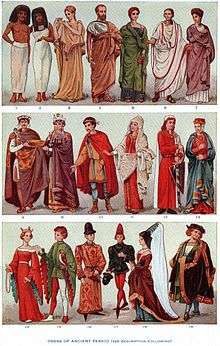
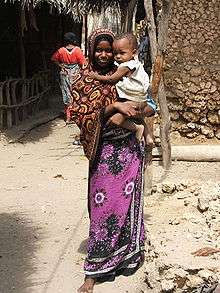
Clothing serves many purposes: it can serve as protection from the elements, rough surfaces, rash-causing plants, insect bites, splinters, thorns and prickles by providing a barrier between the skin and the environment. Clothes can insulate against cold or hot conditions, and they can provide a hygienic barrier, keeping infectious and toxic materials away from the body. Clothing also provides protection from ultraviolet radiation.
Wearing clothes is also a social norm, and being deprived of clothing in front of others may be embarrassing. In most parts of the world, not wearing clothes in public so that genitals, breasts or buttocks are visible could be considered indecent exposure.
Origin and history
Early use
Scientists are still debating when people started wearing clothes. Estimates by various experts have ranged from 40,000 to 3 million years ago. Some more recent studies involving the evolution of body lice have implied a more recent development with some indicating a development of around 170,000 years ago and others indicating as little as 40,000. No single estimate is widely accepted.[1][2][3][4]
Ralf Kittler, Manfred Kayser and Mark Stoneking, anthropologists at the Max Planck Institute for Evolutionary Anthropology, conducted a genetic analysis of human body lice that suggests clothing originated around 170,000 years ago. Body lice are an indicator of clothes-wearing, since most humans have sparse body hair, and lice thus require human clothing to survive. Their research suggests that the invention of clothing may have coincided with the northward migration of modern Homo sapiens away from the warm climate of Africa, thought to have begun between 50,000 and 100,000 years ago. However, a second group of researchers using similar genetic methods estimate that clothing originated around 540,000 years ago.[5]
According to archaeologists and anthropologists, the earliest clothing likely consisted of fur, leather, leaves, or grass that were draped, wrapped, or tied around the body. Knowledge of such clothing remains inferential, since clothing materials deteriorate quickly compared to stone, bone, shell and metal artifacts. Archeologists have identified very early sewing needles of bone and ivory from about 30,000 BC, found near Kostenki, Russia in 1988.[6] Dyed flax fibers that could have been used in clothing have been found in a prehistoric cave in the Republic of Georgia that date back to 34,000 BC.[7][8]
Making clothing

Some human cultures, such as the various peoples of the Arctic Circle, traditionally make their clothing entirely of prepared and decorated furs and skins. Other cultures supplemented or replaced leather and skins with cloth: woven, knitted, or twined from various animal and vegetable fibers including wool, linen, cotton, silk, hemp, and ramie.
Although modern consumers may take the production of clothing for granted, making fabric by hand is a tedious and labor-intensive process involving fiber making, spinning, and weaving. The textile industry was the first to be mechanized – with the powered loom – during the Industrial Revolution.
Different cultures have evolved various ways of creating clothes out of cloth. One approach simply involves draping the cloth. Many people wore, and still wear, garments consisting of rectangles of cloth wrapped to fit – for example, the dhoti for men and the sari for women in the Indian subcontinent, the Scottish kilt and the Javanese sarong. The clothes may simply be tied up (dhoti and sari); or pins or belts hold the garments in place (kilt and sarong). The cloth remains uncut, and people of various sizes can wear the garment.
Another approach involves measuring, cutting, and sewing the cloth by hand or with a sewing machine. Clothing can be cut from a sewing pattern and adjusted by a tailor to the wearer's measurements. An adjustable sewing mannequin or dress form is used to create form-fitting clothing. If the fabric is expensive, the tailor tries to use every bit of the cloth rectangle in constructing the clothing; perhaps cutting triangular pieces from one corner of the cloth, and adding them elsewhere as gussets. Traditional European patterns for men's shirts and women's chemises take this approach. These remnants can also be reused to make patchwork hats, vests, and skirts.
Modern European fashion treats cloth much less conservatively, typically cutting in such a way as to leave various odd-shaped cloth remnants. Industrial sewing operations sell these as waste; home sewers may turn them into quilts.
In the thousands of years that humans have been making clothing, they have created an astonishing array of styles, many of which have been reconstructed from surviving garments, photos, paintings, mosaics, etc., as well as from written descriptions. Costume history can inspire current fashion designers, as well as costumiers for plays, films, television, and historical reenactment.
Functions
The most obvious function of clothing is to protect the wearer from the elements. In hot weather, clothing provides protection from sunburn or wind damage. In the cold, it offers thermal insulation. Shelter can reduce the functional need for clothing. For example, coats, hats, gloves and other outer layers are normally removed when entering a warm place. Similarly, clothing has seasonal and regional aspects so that thinner materials and fewer layers of clothing are generally worn in warmer regions and seasons than in colder ones.
Clothing performs a range of social and cultural functions, such as individual, occupational and gender differentiation, and social status.[9] In many societies, norms about clothing reflect standards of modesty, religion, gender, and social status. Clothing may also function as adornment and an expression of personal taste or style.
Clothing has been made from a very wide variety of materials, ranging from leather and furs to woven fabrics to elaborate and exotic natural and synthetic fabrics. Not all body coverings are regarded as clothing. Articles carried rather than worn (such as purses), worn on a single part of the body and easily removed (scarves), worn purely for adornment (jewelry), or those that serve a function other than protection (eyeglasses), are normally considered accessories rather than clothing.
Clothing protects against many things that might injure or irritate the uncovered human body, including rain, snow, wind, and other weather, as well as from the sun. Garments that are too sheer, thin, small or tight offer less protection. Appropriate clothes can also reduce risk during activities such as work or sport. Some clothing protects from specific hazards, such as insects, noxious chemicals, weather, weapons, and contact with abrasive substances.
Humans have devised clothing solutions to environmental or other hazards: such as space suits, air conditioned clothing, armor, diving suits, swimsuits, bee-keeper gear, motorcycle leathers, high-visibility clothing, and other pieces of protective clothing. The distinction between clothing and protective equipment is not always clear-cut, since clothes designed to be fashionable often have protective value and clothes designed for function often consider fashion in their design. The choice of clothes also has social implications. They cover parts of the body that social norms require to be covered, act as a form of adornment, and serve other social purposes. Someone who lacks the means to procure reasonable clothing due to poverty or affordability, or simply lack of inclination, is sometimes said to be scruffy, ragged, or shabby.[10]
Scholarship
Serious books on clothing and its functions appear from the 19th century as imperialists dealt with new environments such as India and the tropics.[11] Some scientific research into the multiple functions of clothing in the first half of the 20th century, with publications such as J.C. Flügel's Psychology of Clothes in 1930,[9] and Newburgh's seminal Physiology of Heat Regulation and The Science of Clothing in 1949.[12] By 1968, the field of environmental physiology had advanced and expanded significantly, but the science of clothing in relation to environmental physiology had changed little.[13] There has since been considerable research, and the knowledge base has grown significantly, but the main concepts remain unchanged, and indeed Newburgh's book is still cited by contemporary authors, including those attempting to develop thermoregulatory models of clothing development.[14]
Cultural aspects
Gender differentiation
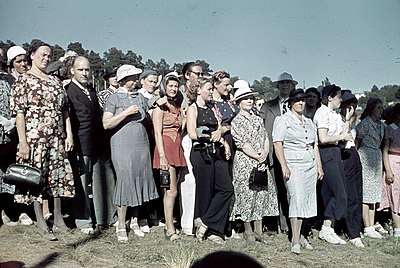 A group of women and men gathered at sport event in Sweden (1938).
A group of women and men gathered at sport event in Sweden (1938). 3rd Duke of Fife wearing a traditional Scottish kilt skirt (1984).
3rd Duke of Fife wearing a traditional Scottish kilt skirt (1984). A Hindu North Indian wedding, with the groom wearing a sherwani and pagri turban, while the bride in a sari.
A Hindu North Indian wedding, with the groom wearing a sherwani and pagri turban, while the bride in a sari..jpg) Advisor to US President and businesswoman Ivanka Trump (right) along with Japanese PM Shinzō Abe wearing Western-style business suits as per their gender, 2017.
Advisor to US President and businesswoman Ivanka Trump (right) along with Japanese PM Shinzō Abe wearing Western-style business suits as per their gender, 2017._-_The_Road_(3).jpg) Red carpet fashion: Italian actors Gabriel Garko and Laura Torrisi wearing designer dress code, 2009. The man is in suit and the woman is wearing a gown.
Red carpet fashion: Italian actors Gabriel Garko and Laura Torrisi wearing designer dress code, 2009. The man is in suit and the woman is wearing a gown.
In most cultures, gender differentiation of clothing is considered appropriate. The differences are in styles, colors, fabrics, and types.
In Western societies, skirts, dresses, and high-heeled shoes are usually seen as women's clothing, while neckties are usually seen as men's clothing. Trousers were once seen as exclusively men's clothing, but can nowadays be worn by both genders. Men's clothes are often more practical (that is, they can function well under a wide variety of situations), but a wider range of clothing styles are available for women. Men are typically allowed to bare their chests in a greater variety of public places. It is generally common for a woman to wear clothing perceived as masculine, while the opposite is seen as unusual.
In some cultures, sumptuary laws regulate what men and women are required to wear. Islam requires women to wear more modest forms of attire, usually hijab. What qualifies as "modest" varies in different Muslim societies; however, women are usually required to cover more of their bodies than men. Articles of clothing Muslim women wear for modesty range from the head-scarf to the burqa.
Men may sometimes choose to wear men's skirts such as togas or kilts in particular cultures, especially on ceremonial occasions. Such garments were (in previous times) often worn as normal daily clothing by men.
Clothing designed to be worn by either sex is called unisex clothing. Unisex clothes, such as T-shirts, tend to be cut straighter to fit a wider variety of bodies. The majority of unisex clothing styles have started out as menswear, but some articles, like the fedora, were originally worn by women.
Social status
- Achkan sherwani and churidar (lower body) worn by Arvind Singh Mewar and his kin during a Hindu wedding in Rajasthan, India. Traditionally, these clothes were worn by the elites of the Indian subcontinent.
 A Barong Tagalog made for a wedding ceremony.
A Barong Tagalog made for a wedding ceremony.
In some societies, clothing may be used to indicate rank or status. In ancient Rome, for example, only senators could wear garments dyed with Tyrian purple. In traditional Hawaiian society, only high-ranking chiefs could wear feather cloaks and palaoa, or carved whale teeth. In China, before establishment of the republic, only the emperor could wear yellow. History provides many examples of elaborate sumptuary laws that regulated what people could wear. In societies without such laws, which includes most modern societies, social status is instead signaled by the purchase of rare or luxury items that are limited by cost to those with wealth or status. In addition, peer pressure influences clothing choice.
Religion
.jpeg)
 Muslim men traditionally wear white robes and a cap during prayers.
Muslim men traditionally wear white robes and a cap during prayers. Non-liturgical clothing worn by Christian clerics.
Non-liturgical clothing worn by Christian clerics.
Some religious clothing might be considered a special case of occupational clothing. Sometimes it is worn only during the performance of religious ceremonies. However, it may also be worn every day as a marker for special religious status.
For example, Jains and Muslim men wear unstitched cloth pieces when performing religious ceremonies. The unstitched cloth signifies unified and complete devotion to the task at hand, with no digression. Sikhs wear a turban as it is a part of their religion.
The cleanliness of religious dresses in some religions such as Hinduism, Sikhism, Buddhism, Islam and Jainism is of paramount importance since it indicates purity.
Clothing appears in numerous contexts in the Bible; the most prominent passages are: the story of Adam and Eve who made coverings for themselves out of fig leaves, Joseph's cloak, Judah and Tamar, Mordecai and Esther. Furthermore, the priests officiating in the Temple in Jerusalem had very specific garments, the lack of which made one liable to death.
The Quran says about husbands and wives, regarding clothing: "...They are clothing/covering (Libaas) for you; and you for them" (chapter 2:187).
Jewish ritual also requires rending of one's upper garment as a sign of mourning.
Christian clergy members wear religious vestments during liturgical services and may wear specific non-liturgical clothing at other times.
Contemporary clothing
| Part of a series on |
| Western dress codes and corresponding attires |
|---|
|
|
|
Casual (anything not above) |
|
Supplementary alternatives
|
|
Legend: |
Western dress code
The Western dress code has changed over the past 500+ years. The mechanization of the textile industry made many varieties of cloth widely available at affordable prices. Styles have changed, and the availability of synthetic fabrics has changed the definition of "stylish". In the latter half of the 20th century, blue jeans became very popular, and are now worn to events that normally demand formal attire. Activewear has also become a large and growing market.
Jeans in the Western dress code are worn by both men and women. There are several unique styles of jeans found which include: high rise jeans, mid rise jeans, low rise jeans, bootcut jeans, straight jeans, cropped jeans, skinny jeans, cuffed jeans, boyfriend jeans, and capri jeans.
The licensing of designer names was pioneered by designers like Pierre Cardin in the 1960s and has been a common practice within the fashion industry from about the 1970s. Among the more popular include Marc Jacobs and Gucci, named for Marc Jacobs and Guccio Gucci respectively.
Spread of western styles
_(cropped).jpg)
By the early years of the 21st century, western clothing styles had, to some extent, become international styles. This process began hundreds of years earlier, during the periods of European colonialism. The process of cultural dissemination has perpetuated over the centuries as Western media corporations have penetrated markets throughout the world, spreading Western culture and styles. Fast fashion clothing has also become a global phenomenon. These garments are less expensive, mass-produced Western clothing. Donated used clothing from Western countries are also delivered to people in poor countries by charity organizations.
Ethnic and cultural heritage
People may wear ethnic or national dress on special occasions or in certain roles or occupations. For example, most Korean men and women have adopted Western-style dress for daily wear, but still wear traditional hanboks on special occasions, like weddings and cultural holidays. Items of Western dress may also appear worn or accessorized in distinctive, non-Western ways. A Tongan man may combine a used T-shirt with a Tongan wrapped skirt, or tupenu.
Sport and activity
_(cropped).jpg)
Most sports and physical activities are practiced wearing special clothing, for practical, comfort or safety reasons. Common sportswear garments include shorts, T-shirts, tennis shirts, leotards, tracksuits, and trainers. Specialized garments include wet suits (for swimming, diving or surfing), salopettes (for skiing) and leotards (for gymnastics). Also, spandex materials are often used as base layers to soak up sweat. Spandex is also preferable for active sports that require form fitting garments, such as volleyball, wrestling, track & field, dance, gymnastics and swimming.
.jpg)
Fashion
Paris set the fashion trends for Europe and North America 1900–1940.[15] In the 1920s the goal was all about getting loose. Women wore dresses all day, everyday. Day dresses had a drop waist, which was a sash or belt around the low waist or hip and a skirt that hung anywhere from the ankle on up to the knee, never above. Daywear had sleeves (long to mid-bicep) and a skirt that was straight, pleaded, hank hem, or tired. Jewelry was less conspicuous.[16] Hair was often bobbed, giving a boyish look.[17]
In the 21st century a diverse range of styles exist in fashion, varying by geography, exposure to modern media, economic conditions, and ranging from expensive haute couture to traditional garb, to thrift store grunge. Fashion shows are events for designers to show off new and often extravagant designs.
Political issues
Working conditions in the garments industry
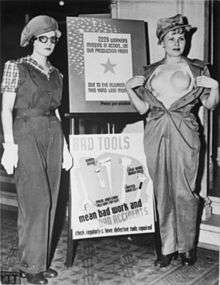
Although mechanization transformed most aspects of human industry by the mid-20th century, garment workers have continued to labor under challenging conditions that demand repetitive manual labor. Mass-produced clothing is often made in what are considered by some to be sweatshops, typified by long work hours, lack of benefits, and lack of worker representation. While most examples of such conditions are found in developing countries, clothes made in industrialized nations may also be manufactured similarly.
Coalitions of NGOs, designers (including Katharine Hamnett, American Apparel, Veja, Quiksilver, eVocal, and Edun) and campaign groups like the Clean Clothes Campaign (CCC) and the Institute for Global Labour and Human Rights as well as textile and clothing trade unions have sought to improve these conditions as much as possible by sponsoring awareness-raising events, which draw the attention of both the media and the general public to the workers.
Outsourcing production to low wage countries like Bangladesh, China, India, Indonesia, Pakistan and Sri Lanka became possible when the Multi Fibre Agreement (MFA) was abolished. The MFA, which placed quotas on textiles imports, was deemed a protectionist measure. Although many countries recognize treaties like the International Labour Organization, which attempt to set standards for worker safety and rights, many countries have made exceptions to certain parts of the treaties or failed to thoroughly enforce them. India for example has not ratified sections 87 and 92 of the treaty.
Despite the strong reactions that "sweatshops" evoked among critics of globalization, the production of textiles has functioned as a consistent industry for developing nations, providing work and wages, whether construed as exploitative or not, to millions of people.[18]
Fur
The use of animal fur in clothing dates to prehistoric times. It is currently associated in developed countries with expensive, designer clothing, although fur is still used by indigenous people in arctic zones and higher elevations for its warmth and protection. Once uncontroversial, it has recently been the focus of campaigns on the grounds that campaigners consider it cruel and unnecessary. PETA, along with other animal rights and animal liberation groups have called attention to fur farming and other practices they consider cruel.
Life cycle
Clothing maintenance
Clothing suffers assault both from within and without. The human body sheds skin cells and body oils, and exudes sweat, urine, and feces. From the outside, sun damage, moisture, abrasion, and dirt assault garments. Fleas and lice can hide in seams. Worn clothing, if not cleaned and refurbished, itches, becomes outworn, and loses functionality (as when buttons fall off, seams come undone, fabrics thin or tear, and zippers fail).
Often, people wear an item of clothing until it falls apart. Some materials present problems. Cleaning leather is difficult, and bark cloth (tapa) cannot be washed without dissolving it. Owners may patch tears and rips, and brush off surface dirt, but materials like these inevitably age.
However, most clothing consists of cloth, and most cloth can be laundered and mended (patching, darning, but compare felt).
Laundry, ironing, storage
Humans have developed many specialized methods for laundering, ranging from early methods of pounding clothes against rocks in running streams, to the latest in electronic washing machines and dry cleaning (dissolving dirt in solvents other than water). Hot water washing (boiling), chemical cleaning and ironing are all traditional methods of sterilizing fabrics for hygiene purposes.
Many kinds of clothing are designed to be ironed before they are worn to remove wrinkles. Most modern formal and semi-formal clothing is in this category (for example, dress shirts and suits). Ironed clothes are believed to look clean, fresh, and neat. Much contemporary casual clothing is made of knit materials that do not readily wrinkle, and do not require ironing. Some clothing is permanent press, having been treated with a coating (such as polytetrafluoroethylene) that suppresses wrinkles and creates a smooth appearance without ironing.
Once clothes have been laundered and possibly ironed, they are usually hung on clothes hangers or folded, to keep them fresh until they are worn. Clothes are folded to allow them to be stored compactly, to prevent creasing, to preserve creases or to present them in a more pleasing manner, for instance when they are put on sale in stores.
Certain types of insects and larvae feed on clothing and textiles, such as the Black carpet beetle and Clothing moths. To deter such pests, clothes may be stored in cedar-lined closets[19] or chests, or placed in drawers or containers with materials having pest repellent properties, such as Lavender or mothballs. Airtight containers (such as sealed, heavy-duty plastic bags) may also deter insect pest damage to clothing materials.
Non-iron
A resin used for making non-wrinkle shirts releases formaldehyde, which could cause contact dermatitis for some people; no disclosure requirements exist, and in 2008 the U.S. Government Accountability Office tested formaldehyde in clothing and found that generally the highest levels were in non-wrinkle shirts and pants.[20] In 1999, a study of the effect of washing on the formaldehyde levels found that after 6 months after washing, 7 of 27 shirts had levels in excess of 75 ppm, which is a safe limit for direct skin exposure.[21]
Mending
When the raw material – cloth – was worth more than labor, it made sense to expend labor in saving it. In past times, mending was an art. A meticulous tailor or seamstress could mend rips with thread raveled from hems and seam edges so skillfully that the tear was practically invisible. Today clothing is considered a consumable item. Mass-manufactured clothing is less expensive than the labor required to repair it. Many people buy a new piece of clothing rather than spend time mending. The thrifty still replace zippers and buttons and sew up ripped hems.
Recycling
Used, unwearable clothing can be repurposed for quilts, rags, rugs, bandages, and many other household uses. Neutral colored or undyed cellulose fibers can be recycled into paper. In Western societies, used clothing is often thrown out or donated to charity (such as through a clothing bin). It is also sold to consignment shops, dress agencies, flea markets, and in online auctions. Used clothing is also often collected on an industrial scale to be sorted and shipped for re-use in poorer countries. Globally, used clothes are worth $4 billion[22] with the US as the leading exporter at $575 million.[23]
There are many concerns about the life cycle of synthetics, which come primarily from petrochemicals. Unlike natural fibers, their source is not renewable and they are not biodegradable.[24]
Excess inventory of clothing is sometimes destroyed to preserve brand value.[25]
Global trade
EU Member States import, in 2018 €166 billion of clothes; 51% come from outside the EU €84 billion.
EU member states exported €116 billion of clothes in 2018, including 77% to other EU member states.
 |
 |
Sources: Eurostat.[26] | |
See also
References
- Ralf Kittler, Manfred Kayser & Mark Stoneking (2003), "Molecular evolution of Pediculus humanus and the origin of clothing" (PDF), Current Biology, 13 (16): 1414–1417, doi:10.1016/S0960-9822(03)00507-4, PMID 12932325, archived from the original (PDF) on 2008-09-10
- Kittler, Ralf; Kayser, Manfred; Stoneking, Mark (2004). "Molecular Evolution of Pediculus humanus and the Origin of Clothing". Current Biology. 14 (24): 2309. doi:10.1016/j.cub.2004.12.024.
- Toups, Melissa A.; et al. (January 2011). "Origin of Clothing Lice Indicates Early Clothing Use by Anatomically Modern Humans in Africa". Molecular Biology and Evolution. 28 (1): 29–32. doi:10.1093/molbev/msq234. PMC 3002236. PMID 20823373.
- Reed, David; et al. (2007). "Pair of lice lost or parasites regained: The evolutionary history of Anthropoid primate lice". BMC Biology. 5 (7): 7. doi:10.1186/1741-7007-5-7. PMC 1828715. PMID 17343749.
- Reed; et al. (2004). "Genetic Analysis of Lice Supports Direct Contact between Modern and Archaic Humans". PLoS Biology. 2 (11): e340. doi:10.1371/journal.pbio.0020340. PMC 521174. PMID 15502871.
- Hoffecker, J., Scott, J., Excavations In Eastern Europe Reveal Ancient Human Lifestyles, University of Colorado at Boulder News Archive, March 21, 2002, colorado.edu Archived 2011-07-19 at the Wayback Machine
- Balter M (2009). "Clothes Make the (Hu) Man". Science. 325 (5946): 1329. doi:10.1126/science.325_1329a. PMID 19745126.
- Kvavadze E, Bar-Yosef O, Belfer-Cohen A, Boaretto E, Jakeli N, Matskevich Z, Meshveliani T (2009). "30,000-Year-Old Wild Flax Fibers". Science. 325 (5946): 1359. doi:10.1126/science.1175404. PMID 19745144. Supporting Online Material
- Flugel, John Carl (1976) [1930], The Psychology of Clothes, International Psycho-analytical Library, No.18, New York: AMS Press. First published by Hogarth Press, London, ISBN 0-404-14721-6 Alternative ISBN 978-0-404-14721-1 (This work is one of the earliest attempts at an overview of the psycho-social and practical functions of clothing)
- Baradel, Lacey. "Geographic Mobility and Domesticity in Eastman Johnson’s The Tramp." American Art 28.2 (2014): 26–49
- e.g. Jeffreys, Julius (1858), The British Army in India: Its Preservation by an appropriate Clothing, Housing, Locating, Recreative Employment, and Hopeful Encouragement of the Troops, London: Longman, Brown, Green, Longmans & Roberts, retrieved 8 September 2010
- Newburgh, Louis Harry, ed. (1968) [1949], Physiology of Heat Regulation and The Science of Clothing, New York & London: Hafner Publishing
- Hertig, Bruce A (February 1969), "Book review: Physiology of Heat Regulation and the Science of Clothing", Journal of Occupational and Environmental Medicine, 11 (2): 100, doi:10.1097/00043764-196902000-00012, PMC 1520373 (reviewer's name appears next to Newburgh, but was not the co-author. See also reviewer's name at bottom of page).
- Gilligan, Ian (January 2010), "The Prehistoric Development of Clothing: Archaeological Implications of a Thermal Model", Journal of Archaeological Method and Theory, 17 (1): 15–80, doi:10.1007/s10816-009-9076-x
- Mary Louise Roberts, "Samson and Delilah revisited: the politics of women's fashion in 1920s France." American Historical Review 98.3 (1993): 657–684.
- Simon Bliss, "'L’intelligence de la parure': Notes on Jewelry Wearing in the 1920s." Fashion Theory 20.1 (2016): 5–26.
- Steven Zdatny, "The Boyish Look and the Liberated Woman: The Politics and Aesthetics of Women's Hairstyles." Fashion Theory 1.4 (1997): 367–397.
- European Parliamentary Research Service. “Workers' Conditions in the Textile and Clothing Sector: Just an Asian Affair?” European Parliament, Aug. 2014. www.europarl.europa.eu/EPRS/140841REV1-Workers-conditions-in-the-textile-and-clothing-sector-just-an-Asian-affair-FINAL.pdf.
- "Cedar Closets 101". Bob Vila. 2017-09-08. Retrieved 2019-06-12.
- When Wrinkle-Free Clothing Also Means Formaldehyde Fumes. New York Times.
- Changes of Free Formaldehyde Quantity in Non-iron Shirts by Washing and Storage Archived 2011-07-22 at the Wayback Machine. Journal of Health Science.
- Minter, Adam (15 January 2018). "No One Wants Your Used Clothes Anymore". Bloomberg View. Retrieved 17 January 2018.
- Banigan, Melissa (25 January 2018). "East Africa Doesn't Want Your Hand-Me-Downs". Racked. Vox Media. Retrieved 26 January 2018.
- The Textile Materials Eco Battle Between Natural and Synthetic Fabrics "Steven E. Davis, Sweatshirt Station".
- Lieber, Chavie (17 September 2018). "Why fashion brands destroy billions' worth of their own merchandise every year". Vox. Retrieved 17 September 2018.
- http://ec.europa.eu/eurostat/web/products-eurostat-news/-/EDN-20190422-1?inheritRedirect=true&redirect=%2Feurostat%2Fnews%2Fwhats-new%3Fp_p_id%3D101_INSTANCE_AJ2so9Q6Ai6F%26p_p_lifecycle%3D0%26p_p_state%3Dnormal%26p_p_mode%3Dview%26p_p_col_id%3Dcolumn-2%26p_p_col_count%3D1%26_101_INSTANCE_AJ2so9Q6Ai6F_delta%3D20%26_101_INSTANCE_AJ2so9Q6Ai6F_keywords%3D%26_101_INSTANCE_AJ2so9Q6Ai6F_advancedSearch%3Dfalse%26_101_INSTANCE_AJ2so9Q6Ai6F_andOperator%3Dtrue%26p_r_p_564233524_resetCur%3Dfalse%26_101_INSTANCE_AJ2so9Q6Ai6F_cur%3D2
Further reading
- Finnane, Antonia (2008), Changing Clothes in China: Fashion, History, Nation, New York: Columbia University Press, ISBN 978-0-231-14350-9, retrieved 8 September 2010 ebook ISBN 978-0-231-51273-2
- Forsberg, Krister; Mansdorf, S.Z (2007), Quick Selection Guide to Chemical Protective Clothing (5th ed.), Hoboken, New Jersey: John Wiley & Sons, ISBN 978-0-470-14681-1, retrieved 8 September 2010
- Gavin, Timothy P (2003), "Clothing and Thermoregulation During Exercise", Sports Medicine, 33 (13): 941–947, doi:10.2165/00007256-200333130-00001, PMID 14606923, archived from the original on 2011-07-07, retrieved 8 September 2010
- Hollander, Anne L (1993), Seeing Through Clothes, Berkeley: University of California Press, ISBN 0-520-08231-1, retrieved 8 September 2010
- Montain, Scott J; Sawaka, Michael N; Cadarett, Bruce S; Quigley, Mark D; McKay, James M (1994), "Physiological tolerance to uncompensable heat stress: effects of exercise intensity, protective clothing, and climate" (PDF), Journal of Applied Physiology, 77 (1): 216–222, doi:10.1152/jappl.1994.77.1.216, PMID 7961236, retrieved 8 September 2010
- Ross, Robert (2008), Clothing, a Global History: or, The Imperialist's New Clothes, Cambridge, UK: Polity Press, ISBN 978-0-7456-3186-8, retrieved 8 September 2010 Paperback ISBN 978-0-7456-3187-5
- Tochihara, Yutaka; Ohnaka, Tadakatsu, eds. (2005), Environmental Ergonomics: The Ergonomics of Human Comfort, Health and Performance in the Thermal Environment, Elsevier Ergonomics Book Series, Vol.3, Amsterdam & Boston: Elsevier, pp. 315–320, ISBN 0-08-044466-0, retrieved 8 September 2010 (see especially sections 5 – 'Clothing' – & 6 – 'Protective clothing').
- Yarborough, Portia; Nelson, Cherilyn N, eds. (2005), "Performance of Protective Clothing: Global Needs and Emerging Markets", Performance of Protective Clothing, West Conshohocken, PA: ASTM International, 8th Vol., ISBN 0-8031-3488-6, ISSN 1040-3035, retrieved 8 September 2010
External links
- BBC Wiltshire Dents Glove Museum
- International Textile and Apparel Association, scholarly publications
- German Hosiery Museum (English language)
- Molecular Evolution of Pediculus humanus and the Origin of Clothing by Ralf Kittler, Manfred Kayser and Mark Stoneking (.PDF file)
- Cornell Home Economics Archive: Research, Tradition, History (HEARTH)
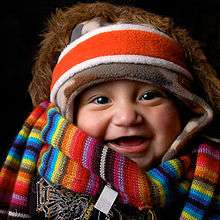
_(cropped).jpg)
.jpg)
.jpg)
_(cropped).jpg)